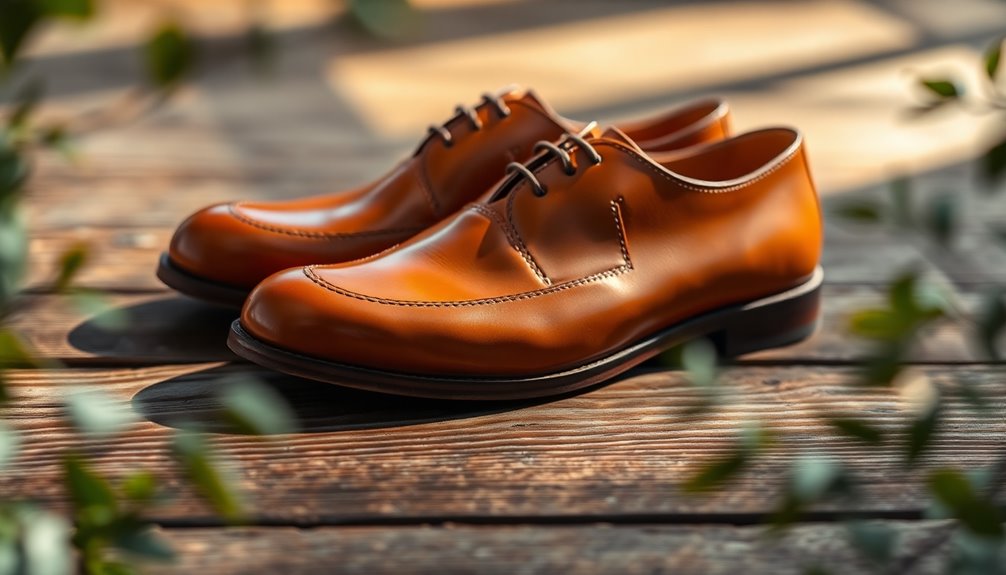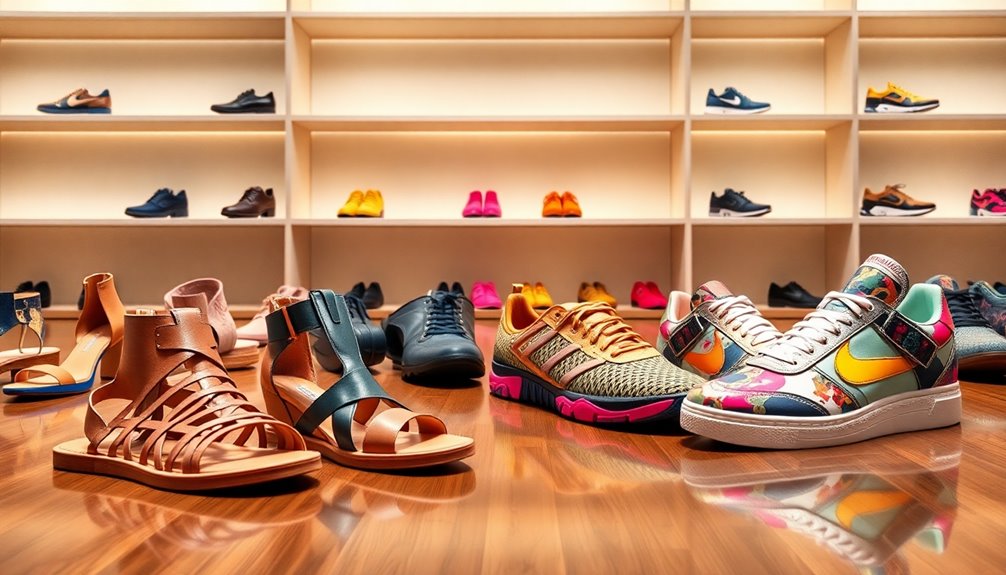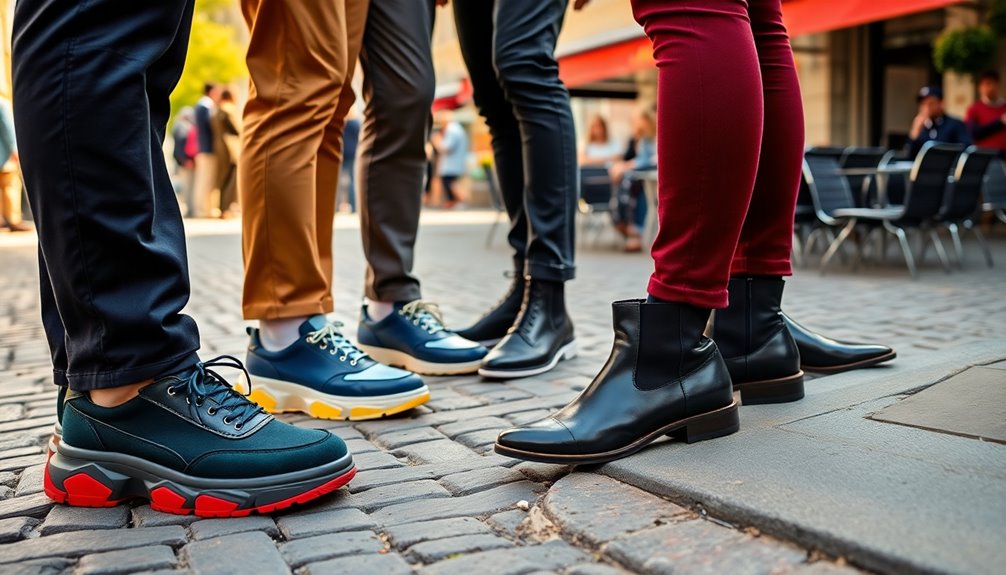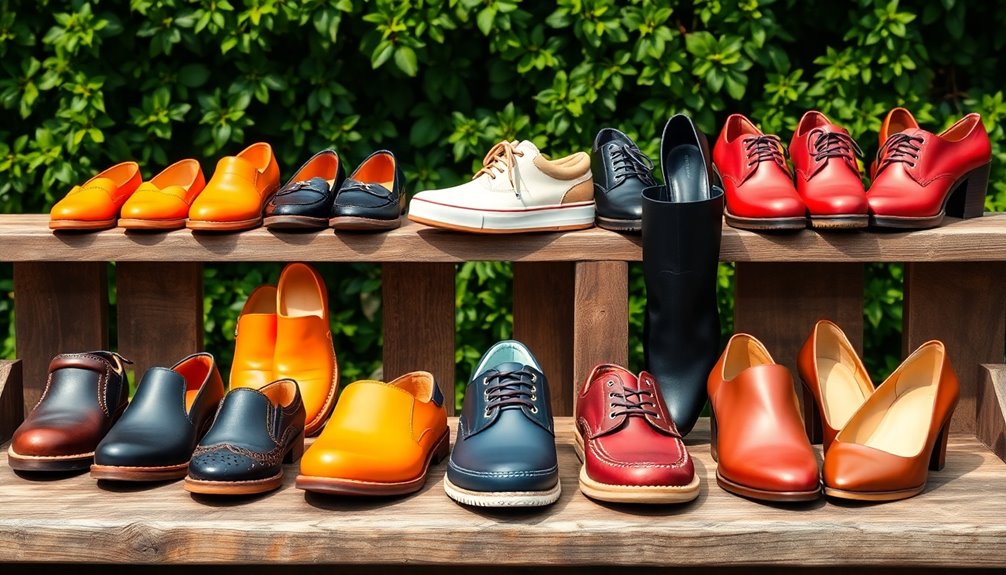If you're looking to elevate your style, Dutch shoes are a must-have. Originally crafted for protection and comfort, these iconic wooden clogs blend history with modern fashion. Their orthopedic design ensures healthy posture while making them easy to slip on and off for any occasion. Plus, they come in various styles that can be integrated into your wardrobe, from casual outings to trendy outfits. Made with traditional craftsmanship techniques, each pair tells a story of heritage. Discover how you can incorporate these unique shoes into your collection and stand out effortlessly.
Key Takeaways
- Dutch shoes offer a unique blend of traditional craftsmanship and modern style, making them a fashionable choice for various outfits.
- Their orthopedic design promotes comfort, ensuring your feet feel great while elevating your overall look.
- Contemporary styles of Dutch shoes incorporate bold colors and patterns, aligning with current fashion trends for a chic appearance.
- Versatile enough for casual outings or special occasions, Dutch shoes can be paired with wide-leg jeans or dresses for effortless style.
- Sustainability in production enhances their appeal, catering to consumers seeking ethical and stylish footwear options.
History of Dutch Wooden Shoes
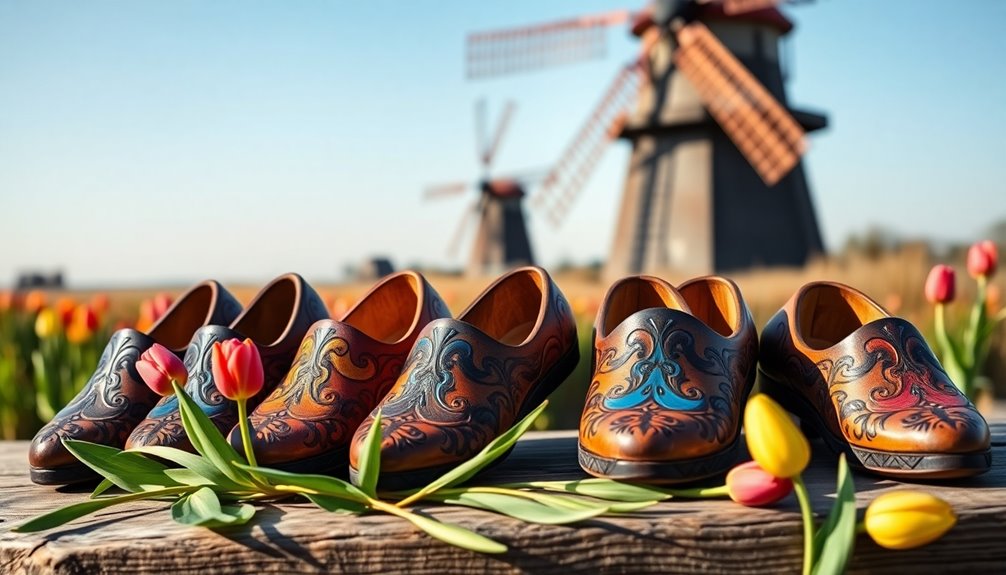
Dutch wooden shoes, known as "klompen," have a rich history that dates back to the 13th century in the Netherlands. The earliest klompen were discovered in a peat bog in Drenthe and during the construction of the Amsterdam Metro, dating around 1230. Made from a single piece of wood, these shoes were secured to the foot with leather straps, providing durable footwear for farmers and the working class.
The design drew inspiration from Roman sandals but was adapted for the Dutch climate, maximizing protection. As the agrarian economy flourished in the 16th and 17th centuries, wooden shoes gained immense popularity. In this period, they became essential for those working in the agrarian economy, showcasing the importance of functionality in daily life.
By the 18th and 19th centuries, production became more industrialized, introducing a two-piece design with separate soles and uppers. This innovation allowed for the use of various woods like willow and poplar, making klompen cheaper and more accessible to the poorer classes.
Wooden shoes symbolize Dutch culture and resilience, with roots in folklore and traditional clog dancing. While urban popularity waned in the 20th century, klompen remain a testament to Dutch heritage, blending practicality and cultural significance.
Practical Benefits of Dutch Shoes
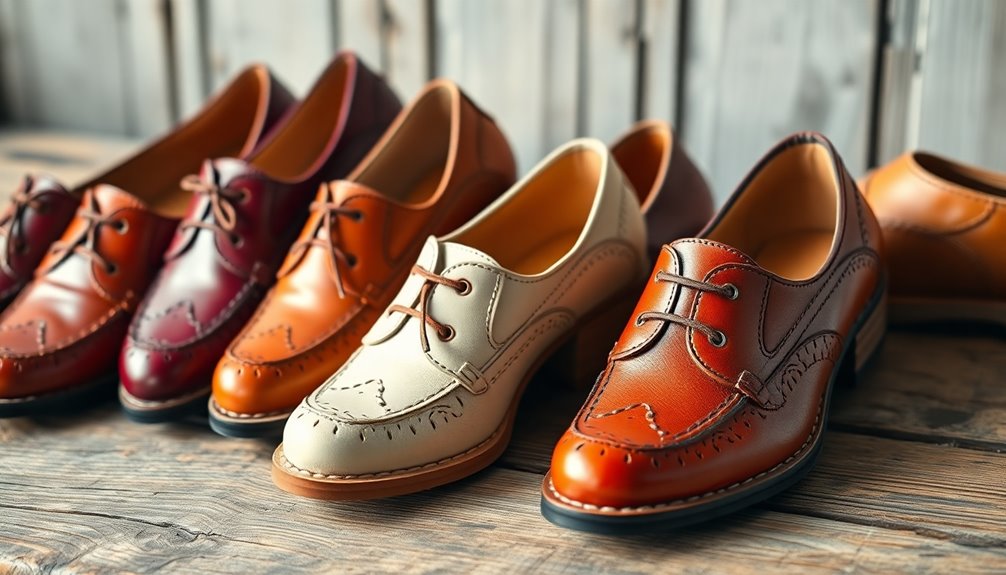
When it comes to practical footwear, few options rival the benefits of klompen. These sturdy wooden shoes offer robust protection against extreme heat and sharp objects, making them perfect for hazardous work environments. You can confidently wear them around blast furnaces or rolling mills, knowing your feet are shielded from heavy tools and even stomping animals like dairy cows.
Klompen are also waterproof and insulating, keeping your feet dry in wet conditions. Whether you're gardening or working on a farm, their ability to maintain temperature means your feet stay warm in winter and cool in summer. Plus, they prevent sweaty feet, ensuring comfort throughout the day. The benefits of wooden shoes include their durability and unique designs, which enhance their appeal.
The orthopedic design of these shoes provides excellent support, promoting healthy posture and reducing foot discomfort. They're easy to slip on and off, making them ideal for quick outdoor tasks.
You'll find klompen indispensable not just for work but also for daily chores around the house and garden. And when they eventually wear out, you can even repurpose them as quirky planters.
With all these practical benefits, klompen truly become a versatile addition to your footwear collection.
Cultural Significance and Heritage

Klompen aren't just practical footwear; they also carry a rich cultural significance that reflects the heritage of the Netherlands. Dating back over 800 years, these wooden shoes emerged in the 13th century, becoming essential for farmers and fishermen by the 16th century.
Crafted from hardwoods like oak and ash, klompen protected feet from damp conditions while showcasing the values of resilience and craftsmanship inherent in Dutch culture. Skilled artisans use locally sourced woods like alder, beech, and sycamore to create these durable shoes, ensuring that each pair is a testament to traditional craftsmanship.
As you explore this cultural identity, you'll find that wooden shoes symbolize traditional rural professions, often linked to clog dancing—a lively expression of Dutch spirit.
Ornately designed clogs were reserved for special occasions, including weddings and church services, while also serving as unique proposal gifts in some customs.
In Dutch folklore, the distinct sound of wooden shoes resonated with social standing, as intricate carvings signified wealth.
Today, while modern adaptations exist, traditional craftsmanship is preserved in workshops like Kooijman in Zaanse Schans.
Although klompen are less common in everyday life, they remain a proud expression of Dutch heritage, drawing tourists eager to take home a piece of this unique tradition.
Traditional Craftsmanship Techniques

Crafting traditional wooden clogs is a meticulous process that showcases the skill and artistry of craftsmen. You begin by selecting tree trunks, focusing on size and shape to ensure the wood is suitable for your clogs. Typically, you'll choose poplar, willow, or alder, known for their durability and lightweight nature. Tradition dictates poplar wood or willow as the ideal materials for wooden shoes.
Once the trunk is cut, you divide the wood into equal pieces, carefully considering the condition of the branches and bark to ease splitting.
Next, you shape the wood using hand-operated machines. You trim away the bark and use a gouge to define the clog's outer shape. Revolving knives trace the model prototype, while a sharp drill hollows out the inside.
Finishing touches come next; you drill holes and pin the clogs to a rig to prevent damage. Hand tools, like paalmes, shape the heel and toe, and you smooth the surfaces with sandpaper or grinding belts.
Finally, the clogs air-dry for several weeks, hardening to perfection. You can choose to finish them naturally or with a matte lacquer for weather resistance, adding personal designs to create a unique final product.
Modern Usage and Trends

The rich tradition of Dutch clogs has paved the way for modern footwear trends that reflect both comfort and style. Today, Adidas Samba sneakers dominate the streets of Amsterdam, while dad sneakers from New Balance and Asics are celebrated for their perfect blend of comfort and chic. Chunky sneakers are particularly favored for daily biking and casual outings, offering both practicality and flair.
When it comes to styling, you'll find sneakers paired effortlessly with wide-leg, low-rise jeans or loose-fitted pants, creating a laid-back look. Layering remains a staple, with skirts often worn over baggy pants and oversized tops. Additionally, the influence of whole foot clogs continues to inspire contemporary designs, merging functionality with aesthetic appeal.
Edgy lace accents are gaining traction in street style, especially when combined with oversized jackets and monochromatic outfits. Color blocking and neutral tones enhance versatility, allowing you to mix and match easily.
The influence of global fashion is undeniable, as high-end brands have showcased Dutch clogs on prominent runways. This interplay between traditional and modern styles keeps Dutch fashion dynamic, ensuring you can elevate your wardrobe while prioritizing comfort and practicality.
Embrace these trends and step out in style!
Economic Impact and Legacy
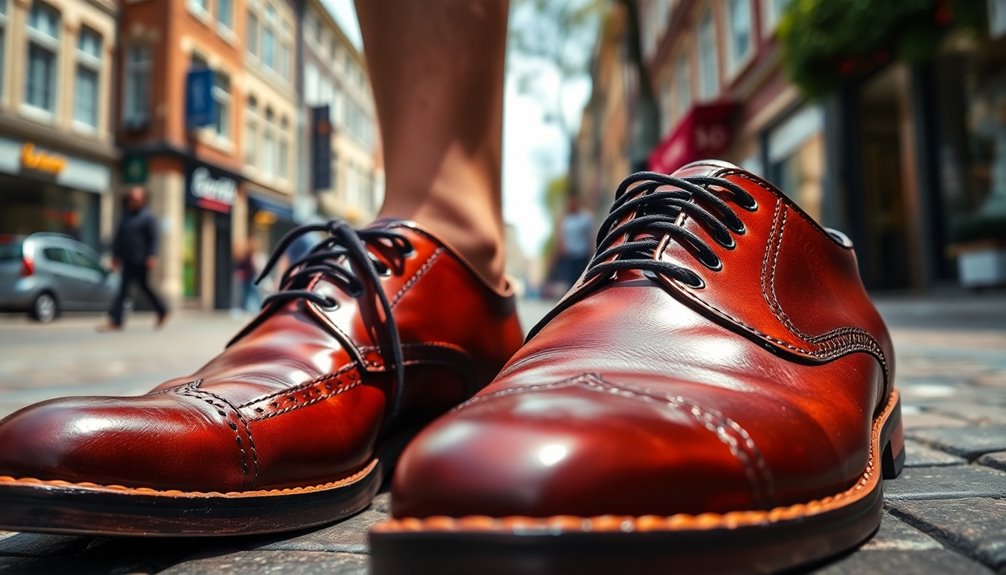
Dutch footwear has a significant economic footprint, with the market projected to reach USD 2.49 billion by 2025. In 2020, the total revenues of the Dutch footwear market stood at $3.1 billion, despite a slight decline of -0.5% between 2016 and 2020. The growth is primarily driven by an increasing demand for stylish, high-quality products and improvements in the labor market.
Women's footwear alone generated $1.5 billion, making it the most profitable segment. With 92%-94% of the population online, e-commerce is expected to expand rapidly, allowing you to shop more conveniently. The market is segmented by type—men, women, and children—and by distribution channels, with online sales gaining traction. Furthermore, the demand for stylish and high-quality products is significantly influencing market growth.
However, challenges remain, such as high prices from multinational brands and the impact of Covid-19 on retail. Culturally, Dutch footwear, particularly wooden clogs, has historical significance dating back to the 13th century, symbolizing resilience. Although clogs are now mainly found in souvenir shops, their legacy endures, reminding you of the practical roots of Dutch footwear.
As the market evolves, innovation and competition will likely shape the future of Dutch shoe style.
Frequently Asked Questions
What Styles of Dutch Shoes Are Currently Trending?
Currently, you'll find a mix of traditional and modern styles of Dutch shoes trending.
Look for clogs featuring high heels or open toes that blend comfort with chic designs. Interchangeable uppers also offer versatility, allowing you to switch up your look effortlessly.
Luxury brands are showcasing these styles in their collections, making them a stylish choice to pair with contemporary outfits.
How Do I Properly Care for My Dutch Shoes?
To properly care for your shoes, start by removing dirt with a horsehair brush or damp cloth.
For deeper cleaning, use saddle soap and air dry.
Apply a leather conditioner to maintain the material's health and polish for shine.
Always air dry your shoes and store them in a cool, dry place.
To preserve their shape, use shoe trees or stuffing when not in use.
Avoid heat and harsh cleaners on the leather.
Where Can I Buy Authentic Dutch Shoes?
If you're looking to buy authentic Dutch shoes, check out online retailers like Hollands Klompenhuis and Dutch-Clogs.com for a variety of traditional designs.
You'll find options ranging from handmade wooden clogs to decorative pieces. Netherlands Souvenirs offers unique souvenir styles, while Dutch Gift Outlet features historical motifs.
Many shops provide fast shipping and return policies, so you can shop confidently. Just make sure to refer to sizing charts for the best fit!
Are Dutch Shoes Suitable for All-Day Wear?
Yes, Dutch shoes are definitely suitable for all-day wear.
They're designed with comfort in mind, featuring breathable wood that keeps your feet cool and cushioned insoles for support. The ergonomic footbeds ensure even pressure distribution, making them ideal for long hours on your feet.
Plus, their durability and protective qualities mean you can confidently wear them in various settings, whether you're at work or enjoying a casual day out.
You'll appreciate their versatility!
What Sizes Are Available for Dutch Wooden Shoes?
Dutch wooden shoes are available in a wide range of sizes, from EUR 19 to EUR 47.
This translates to USA sizes 3 to 13 for kids and 2 to 14 for adults, while UK sizes range from 3 to 13 for kids and 1 to 13 for adults.
To find your perfect fit, measure your foot length and consult conversion tables to ensure you choose the right size for comfort and support.
Conclusion
In conclusion, Dutch shoes aren't just a fashion statement; they blend history, practicality, and culture in every pair. By embracing their unique craftsmanship and modern trends, you'll elevate your style while honoring a rich legacy. Whether you're stepping into the past or striding into the future, these must-have shoes add character to your wardrobe. So why not invest in a pair and experience the charm and comfort of Dutch footwear for yourself?
